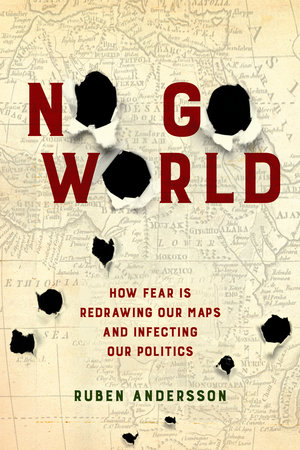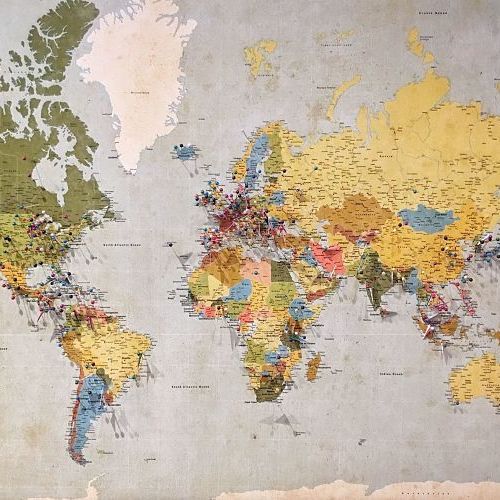 Andersson’s new opus is a haunting and insightful examination of those remote zones of danger and insecurity that are distant yet at the centre of ‘our new world disorder’ (p3). No Go World outlines how economies of risks and politics of fear are firmly entangled – with dramatic consequences for many, including those contained in the buffer zones around rich Western nations and the expendable intermediaries bearing the brunt of risky interventions in situations of crisis managed increasingly remotely. In keeping in line with the focus of Andersson’s previous book and its insightful exploration of the ‘illegality industry’, there is again a prominent cui bono thread running through No Go World. In this forbidding story of ‘global distancing and endangerment’ (p6), Andersson eloquently highlights how the production of insecurity and danger in fact benefits some lines of business, thereby creating both ‘winners and losers’ (p20) as those attempting to ward off danger also end up stoking it. However, the sense of control over remote zones of danger, as argued by Andersson, is ultimately illusory as ‘such remote interventions tend to generate as many problems as they purportedly solve’ (p240).
Andersson’s new opus is a haunting and insightful examination of those remote zones of danger and insecurity that are distant yet at the centre of ‘our new world disorder’ (p3). No Go World outlines how economies of risks and politics of fear are firmly entangled – with dramatic consequences for many, including those contained in the buffer zones around rich Western nations and the expendable intermediaries bearing the brunt of risky interventions in situations of crisis managed increasingly remotely. In keeping in line with the focus of Andersson’s previous book and its insightful exploration of the ‘illegality industry’, there is again a prominent cui bono thread running through No Go World. In this forbidding story of ‘global distancing and endangerment’ (p6), Andersson eloquently highlights how the production of insecurity and danger in fact benefits some lines of business, thereby creating both ‘winners and losers’ (p20) as those attempting to ward off danger also end up stoking it. However, the sense of control over remote zones of danger, as argued by Andersson, is ultimately illusory as ‘such remote interventions tend to generate as many problems as they purportedly solve’ (p240).
No Go World displays a broad scope, both in terms of geographical focus and the range of actors and organisations revolving around those danger zones. Although it sometimes begs for more ethnographic encounters in and around those marginal regions depicted as hotbeds of danger and insecurity, Andersson nimbly points out how he was himself kept at bay from such zones, stalled by university ethics and risk assessment procedures, themselves closely entwined with the wider web of vested interests deep-rooted into risk calculus. It is worth noting here, in addition to his remarks about the increasing difficulties for researchers to go into regions deemed too dangerous, that carrying out collaborative and participatory research projects with those confined to the regions of the world deemed unsanitary and dangerous is also hindered when collaborators cannot cross over the other way. In the UK context, Alison Phipps, the UNESCO chair for refugee integration, recently denounced the ‘discriminatory’ and ‘embarrassing’ visitor visa system and accused the British government of effectively setting up ‘a secret travel ban’, preventing academics, especially from Africa and the Middle East, to visit and take part in project activities – even when they are fully sponsored and the events are, ironically, government-funded.
The denial of visas to academics from beyond the confines of affluent and security-obsessed western nations is not surprising. It occurs in an age of fast mobility for the happy few and forceful containment for the rest – with a rising tally in terms of human lives lost to hostile migration politics. Andersson does not profess to offer a magical cure amidst his diagnosis of the ‘interventionist ills besetting especially Western (and West-backed) power’ (p17) yet he sketches out a number of crucial cardinal points for anthropologists and others who wish to counter the prevailing cartography of danger.
We need a new story, a new map which take cue of how the dominant map of fear and risk work, but one which charts a more positive road ahead to enable us to reconnect.
Trading fear, risk and danger for a cartography that hinges on solidarity, equality and hope is not easy. Yet, elements of such utopian reconnections are already there.
The very journeys made by migrants and refugees out of those danger zones are themselves marked by hope as researchers have relentlessly pointed out. The dominant discourses in public debates about a global ‘migration crisis’ that contribute to fear-peddling politics have fuelled depictions of journeys across the Mediterranean and the Rio Grande (amongst others) as a pervasive threat to western culture, welfare-states, security, job-market, housing stock etc. Such dangerous representations are far from the ways migrants themselves envision their own restricted mobility. While exploring irregular migration in Morocco, I met several young men from sub-Saharan Africa who had undertaken the perilous and uncertain journeys to the Mediterranean region. They hoped to make the next dangerous leap towards Europe, often by crossing into the Spanish enclaves of Ceuta and Melilla. Identitarian movements, obsessed by theories of the ‘great replacement’, have depicted such journeys as violent incursions to plunder and destroy Europe. My informants described themselves as ‘adventurers’ on a quest – they were ‘looking for their lives’ (Bachelet 2019), searching for the opportunities which had been denied to them by political instability and economic precariousness. These dangerous yet hopeful journeys across barbed wire and treacherous waters take place in a deeply uncertain world, where hope is not evenly distributed and where the opulent spectacle of modernity is, for many, something ‘to be seen but not to be touched or lived in’ (Kleist 2016: 4). Although different from the youngsters attracted by the dark zones described by Andersson, ‘adventurers’ from sub-Saharan Africa also talked with enthusiasm and pride about the courage needed to undertake risky journeys towards Europe.
Reframing movement as an opportunity, as suggested by Andersson, is a hard sell at the moment.
The revival of nationalist and far-right movements across Europe illustrates how embracing and welcoming the other, the stranger, is far from the top of the political agenda.
The hostility and criminalization of migration extends towards those who intervene in defence of refugees and other migrants, as illustrated by the arrest of Carola Rackete, captain of the Sea-Watch 3 vessel on 29th June, after she docked into the Lampedusa harbour in defiance of Italian authorities’ order to keep away. The boat carried over 40 migrants rescued from flimsy rubber dinghies on the Mediterranean. Rackete was accused of endangering a military speedboat and its occupants as she forced her way into the harbour, threatened with a lengthy prison sentence and a hefty fine. She apologised, highlighting that “the situation was desperate” and she was only concerned with “bring[ing] exhausted and desperate people to shore”.
The standoff between Carola Rackete and Italian Interior Minister Matteo Salvini who has enforced a ‘closed-ports policy’ is one of the latest in a divided Europe where those daring to rescue and provide assistance to migrants are criminalised and accused of ‘aiding illegal migration’. Beyond the elusive figure of the ‘smuggler’, the type of activities for which individuals (and organizations) can be prosecuted range from giving a lift to migrants, providing food or shelter, preventing deportation flights, helping migrants to cross borders and rescuing people at sea. There has been a series of highly mediatised cases against pro-migration activists (such as Cédric Herou in France, Helena Melano in Spain, Scott Warren in the USA, Elin Ersson in Sweden etc.). In her 2018 report ‘Saving Lives is not a Crime’, Agnès Callamard (Special Rapporteur of the UN Human Rights Council) draws a parallel between acts of solidarity during WW2 and the current migration crisis; she argues that “by criminalizing acts of solidarity, States are violating normative pillars of international human rights and humanitarian law” (OHCHR 2018). Although stories have often focused on European citizens, we should not forget that people on the southern shores of the Mediterranean have also refused the deadly logics of hostile migration politics, as illustrated by the stories of Tunisian fishermen arrested by Italian authorities while towing migrants to safety.
The debates over ‘crimes of solidarity’ and the deterring measures taken against those who provide support to refugees and other migrants are another example of the kind of contagion described by Andersson when he argues that “in a climate of fear, the border emerges as an almost limitless emotional resource for a certain breed of politicians” (p159). In No Go Zones, Andersson powerfully illustrates how the map of dangers that separates black and red zones from safe green ones is fallacious since the ‘danger is not out there but already with us’ (p248).
We must be wary of how those who are complicit in ‘unspooling a long cordon sanitaire across the Mediterranean, promising to separate green from red zones’ (p171) stand to benefit from it.
The criminalisation of those who act in solidarity and support migrants ‘in their unbearable practices of freedom’ (Tazzioli 2018: 10) is a dangerous development. Fears of contamination also affect those accused of treason for holding an ‘open border mindset’ – the enemies-within who threaten to open the flood-gate of the danger zone into the safe, green world and provide a rationale for further policies with the potential to stifle dissent and social movement. Salvini called the incident with Sea Watch 3 “a criminal act, an act of war”, and upon the release of Carola Rackete on 2nd July, he declared that the captain of the Sea Watch 3 vessel should be deported as she was ‘dangerous for national security’. A report by Research Social Platform on Migration and Asylum (ReSOMA) argues that the rise in criminalisation across Europe amidst the proliferation of hostile policy environments for activists and other concerned citizens impedes “the capacity of civil society to effectively and independently promote the fundamental rights of refugees and other migrants, and to uphold the EU’s founding values, such as rule of law, democracy and fundamental rights’ (Vosyliūtė and Conte 2019: 5).
We need anthropologists (amongst others) to critically face up to this emotionally charged politics of fear which endanger the lives of migrants and intimidate those who come forward to provide support despite the increasing risk of prosecution. Andersson’s book offers important insights into the consequences of failed connectivity and is a powerful call for moving beyond a cartography of fear and danger in favour of ‘renewed connections’ (p6). While he is right to point out that anthropologists are yet to overcome ‘a crisis of relevance’ (p260), this book is certainly a firm step in the right direction.
References
Bachelet, S. 2019. Looking for one’s life: Trapped mobilities and adventure in Morocco. In Migration and Society 2 (1): pp. 40-54
Kleist, N. 2016. Introduction: Studying hope and uncertainty in African migration. In Hope and Uncertainty in Contemporary African Migration, edited by Kleist, N. and Thorsen D. London: Routledge.
OHCHR. 2018. Saving lives is not a crime. Report of the Special Rapporteur of the Human Rights Council on extrajudicial, summary or arbitrary executions (Agnes Callamard). A/73/314
Tazzioli, M. 2018. Crimes of solidarity: Migration and containment through rescue. In Radical Philosophy 2.01, pp 4-10.
Vosyliūtė, L. and Conte, C. 2019. Crackdown on NGOs and volunteers helping refugees and other migrants. Research Social Platform on Migration and Asylum.
Ruben Andersson. 2019. No Go World How Fear Is Redrawing Our Maps and Infecting Our Politics. University of California Press.
Featured photo by Andrew Stutesman on Unsplash



